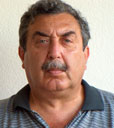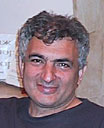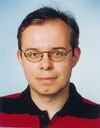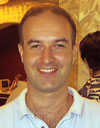
Work Description:
(iii) My current work is on various aspects of Thermal Field Theory. (a) Time-dependent effective theories of superfluids and superconductors; these are non-relativistic versions of the U(1) Goldstone and Higgs models, which present interesting problems in the case of non-static processes at finite temperature. (Phys. Rev. B 62 (2000) II 6638-49) (b) Chiral symmetry breaking, and confinement, in QED in two spatial dimensions, at finite temperature; this theory is similar to QCD in three spatial dimensions at finite temperature. (Nucl. Phys. B 578 (2000) 199-214) (iv) Induced quantum numbers at finite temperature.(Phys. Rev. Lett. 86 (2001) 1690-93)
|
Title of lecture
|
Content
|
|
Field Theory and Standard Model
|
1. QED I: QED as an Abelian gauge theory; from the Lagrangian to the Feynman rules; potentials and particle exchanges. 2. QED II: loops and renormalisation; running charge. 3. Non-Abelian (Yang-Mills) gauge field theories: SU(2), SU(3). 4. Spontaneous symmetry breaking: global and local, Abelian and non-Abelian. 5. The electroweak sector of the Standard Model I: one family. 6. The electroweak sector of the Standard Model II: the Higgs sector, and radiative corrections. The course will follow very closely a similar course I gave at the 2001 European School of High Energy Physics, at Beatenberg, Switzerland. The lecture notes are contained in the Cern "Yellow Report" CERN 2002-002, which is availaable on-line at http://preprints.cern.ch/cgi-bin/setlink?base=cernrep&categ=Yellow_Report&id=2002-002. |
Work Description:
Head of Cosmic Ray Division, Yerevan Physics Institute.
Spokesman of ANI and ASEC collaborations.
Current Scientific Activity:
High Energy Particles Astrophysics:
Origin and acceleration mechanisms of the Cosmic Rays (CR). Physics of the “knee” region. Precise detection of incident fluxes of secondary particles originated from primary nuclei. (Detection of the Extensive Atmospheric Showers – EAS). Determination of the mass composition and energy spectra of the primary flux separately for heavy and light groups of CR nucleus.
Solar Physics & Space Weather.
Acceleration of ions at Sun. Monitoring of sun activity in high energy particles by surface monitors and telescopes. Correlation analysis of all species of secondary cosmic rays. Detection of the solar neutrons and ions. Development of the forecasting and alert center warning for the severe radiation storms.
Multivariate methods of astroparticle data analysis.
Event-by-Event Analysis of EAS data.
Hadronic background rejection for the imaging Atmospheric Cherenkov Telescopes.
Bayesian Decision rules. Development of the Neural Network toolbox providing different training scenarios using the stochastic learning paradigm.
Courses in Yerevan State University Physical Department:
Simulation of Physical Experiments in High Energy Physics;
Introduction to high Energy Astrophysics.
|
Title of lecture
|
Content
|
| Galactic and
Solar Cosmic Rays |
- Cosmic Rays (CR) - another window to Universe. Advantages of Multibandwidth observations (Radio, Optical, X-ray, g-ray and cosmic ray). Joint observations by X-ray and optical telescopes. Nontermal emissions. Mapping of the active regions. Atmospheric Cherenkov Telescopes, hadronic background rejection problem. Mass composition and energy spectra of charged CR in vicinity of Earth. Propagation of radiation in the galactic and intergalactic space. Density and temperature of ambient plasma and gas, strength of the magnetic fields and relict photons density. - Cosmic Ray Astrophysics - sources and acceleration mechanisms: Supernovae explosions and remnants, Active Galaxy Nuclei (AGN), Solar Flares and Coronal Mass Ejections. Acceleration of CR in the magnetic fields. Stochastic and shock acceleration. Particle accelerators on Sun, interacting shocks. Jet phenomena. Relativistic jets from AGN and quasars. Interaction of accretion discs with compact dense cores. Canon ball model. Confinement of ions in magnetic fields. Energy spectra of accelerated ions and it’s dependence on the ion charge. - Space-born and surface facilities for detecting cosmic rays. Extensive Air Showers (EAS). Event-by-Event analysis of EAS data. Charge and position sensitive silicon detectors. Calorimeters. EAS surface arrays. Measurements of electron, muon and hadron content of EAS. Simulation of the EAS development in the atmosphere. Problem of extrapolation of strong interaction models to CR energy range. Multivariate analysis of EAS. Accuracy of EAS parameter estimation. Measurements of Size spectra and angular anisotropy. Changes of the size spectra slope, spectral “knee” interpretations. Energy estimation. CR spectra at highest energies. Spectra cut-off (suppression) problem. - High energy physics with cosmic ray “beams”. Identification of the primary particle type and its energy estimation. Bayesian and Neural statistic models. “Purification” of the “light” and “heavy” ion beams. Constraints on the CR ions mass resolution. Phenomenological parameters of strong interaction measured by the surface calorimeters at projectile energies above 1015 eV. - Cosmic Rays and Earth, Space Weather. Energetic processes on the Sun. Sun activity cycles. Maximal energy attainable by solar accelerators, biggest historical events. Sun-terrestrial connections. Geomagnetic nd Radiation Storms and their consequences. Safety of the Space Operations. Possible precursors of severe storms. Correlated analyses of the variations of secondary CR fluxes. World-wide networks of surface CR monitors. Modulation of the intensity of galactic cosmic rays by sun activity. Correlation of the climate changes with solar cycles. |
Work Description:
My main research interest is the exploration of CP violation, with a focus on decays of B mesons. After the observation of this phenomenon in the B system through the "B factories" at SLAC and KEK in 2001, the goal is now to perform as many consistency checks of the Standard-Model description of CP violation as possible, with the hope to encounter discrepancies, which could shed light on the physics lying beyond the Standard Model. Besides the theoretical interpretation of the current B-factory data, I am especially interested in B-decay studies at the LHC at CERN, where the physics potential of Bs mesons, which are not accessible at the B factories, can be fully exploited.
|
Title of lecture
|
Content
|
| Flavour Physics and CP Violation | We will first motivate why studies of CP violation are interesting, and shall then focus on the Cabibbo-Kobayashi-Maskawa (CKM) matrix, allowing us to accommodate this phenomenon in the Standard Model of electroweak interactions. The central target of the exploration of CP violation is the unitarity triangle (UT) of the CKM matrix, with its angles alpha, beta and gamma. In order to perform stringent tests of the Standard-Model description of CP violation, this triangle has to be overconstrained as much as possible, which can be done through measurements of its sides on the one hand, and its angles on the other hand. We will discuss the relevant processes to determine the sides of the UT, and shall then - after a brief look at the kaon system - move towards CP-violating effects in B-meson decays, which provide measurements the angles of the UT. Here the key role is played by non-leptonic B decays, which are particularly challenging from the theoretical point of view. After discussing the basic features of the framework to deal with such transitions, we will focus on the benchmark modes to explore CP violation, and shall discuss the implications of the currently available B-factory data. The physics programme of the B factories is nicely complemented by B-decay studies at hadron colliders, i.e. run II of the Tevatron and the LHC, where we obtain access to Bs decays. We will discuss characteristic features of Bs decays, as well as strategies to explore CP violation through these transitions. Finally, we will also address "rare" decays of B- and K-mesons, which do not receive contributions at the tree level in the Standard Model, but originate from strongly suppressed loop processes. |
Work Description:
I do research in particle physics, gravitation and cosmology. My current interests are mainly focused on the problem of cosmic acceleration. I am also conducting research on dynamics of supersymmetric gauge theories and applications of these models to particle phenomenology.
|
Title of lecture
|
Content
|
| Beyond the Standard Model | 1. Braneworlds: Introduction to Kaluza-Klein theories; Introduction to Braneworlds; Selected topics in Braneworld phenomenology. 2. Minimal Supersymmetric Standard Model (MSSM): Introduction to supersymmetry (SUSY); SUSY breaking; Selected topics in MSSM phenomenology. 3. (SUSY) Grand Unified Theories (GUT): Introduction to (SUSY) Grand Unification. Selected topics in SUSY GUT phenomenology. |

Work Description:
My main interests are in the field of quantum chromodynamics (QCD) and hadron phenomenology. The recent works are concentrated on applying and developing the method of QCD sum rules. This technique allows one to calculate hadronic decay amplitudes and transition form factors combining short-distance perturbative calculations with universal parameters encoding the long-distance quark-gluon dynamics. In recent years, I was working on the applications of QCD to B physics where a model-independent knowledge of hadronic observables is necessary for extracting the fundamental electroweak parameters from experimental data.
|
Title of lecture
|
Content
|
| Quantum Chromodynamics | 1. Introducing QCD Quarks and gluons of the Standard Model, SU(3) gauge symmetry; the QCD Lagrangian; Feynman diagrams in perturbative QCD; the running of the quark-gluon coupling and quark masses; asymptotic freedom and confinement. 2. From quarks to hadrons The observed spectrum of hadrons: mesons and baryons; light and heavy hadrons; quarkonia; glueballs; flavour symmetries: isospin, SU(3) and heavy quark symmetry. 3. Quark-gluon interactions at short distances Electroweak quark currents; use of perturbative QCD in e++e- to hadrons, deep inelastic scattering and heavy quark decays; separating short- and long-distance interactions with the operator-product expansion. 4. Long-distance dynamics and QCD vacuum Chiral dynamics of hadrons, the quark condensate; probing vacuum condensates with the correlators of quark currents. 5. Calculating hadronic parameters QCD sum rules; quark-hadron duality; why hadrons are not alike; hadronic decay constants and form factors from QCD sum rules; applications to B physics. |

Work Description:
To come.
|
Title of lecture
|
Content
|
| Thermodynamical description of inelastic collisions | The lecture is devoted to the description of various attempts widely used in many laboratories to introduce thermodynamical methods in particle physics. The corresponding phenomenology will be discussed. The S-matrix interpretation of thermodynamics will be introduced to have the quantitative background of these attempts. It allows to find the method of experimental verification of the approach. The peculiarities of the S-matrix interpretation of thermodynamics are clearly seen in comparision with Schwinger-Keldysh real-time thermodynamics, the Matsubara formalism and with Zubarev's noneequilibrium thermodynamics. |
Work Description:
Theory of electroweak interaction. All aspects of physics of massive neutrinos, neutrino mixing and neutrino oscillations. Theory and phenomenology of neutrino oscillations in vacuum. Theory of the resonantly enhanced transitions (oscillations) of neutrinos in matter.
Neutrino physics solutions of the solar neutrino problem and their tests in the future solar neutrino experiments. Matter effects in the oscillations of atmospheric neutrinos. Possible cosmological effects of oscillations of neutrinos. Neutrino mass and lepton mixing generation in the gauge theories, and properties of massive neutrinos. Leptogenesis theory of baryon asymmetry generation. The problem of lepton number nonconservation in gauge theories of electroweak interactions.
.
|
Title of lecture
|
Content
|
| Massive Neutrinos and Neutrino Oscillations | The current status of the neutrino mixing problem will be discussed. The established neutrino properties will be reviewed. The general implications of the nonzero neutrino mass and lepton mixing hypothesis will be considered. These include the existence of: neutrino oscillations, charged lepton flavour changing neutral current (FCNC) processes, neutrinoless double beta decay, and distortion of the 3H __decay spectrum. The existing strong evidences for neutrino mixing and oscillations from the experiments with solar neutrinos and reactor antineutrinos, and from the data on atmospheric neutrinos, will be reviewed. An introduction to the general theory of neutrino mass generation will be given. Examples of neutrino mass generation in the gauge theories of electroweak interaction will be considered. The theory of neutrino oscillations in vacuum and in matter will be reviewed. As applications, the oscillations of solar and atmospheric neutrinos will be considered. Matter effects in the oscillations of neutrinos crossing the Earth will also be discussed. The existing fundamental open questions and future progress in the studies of neutrino mixing will be outlined. In this connection, future neutrinoless double beta decay experiments and long and very long base-line oscillation experiments at accelerators, reactors and neutrino factories will be briefly considered. |

Work Description:
Research interests
My recent research interests are related to highest energy events and largest scales in cosmology and astrophysics. This includes:
1. Cosmology of the very early universe - inflation, its observational predictions, reheating, matter creation and thermalization after inflation, possible signatures of the trans-Planckian physics.
2. Cosmology of the present day universe - dark matter and dark energy problems. 3. Physics of the Ultra-high energy cosmic rays,
Greisen-Zatsepin-Kuzmin puzzle and hints towards its resolution.
|
Title of lecture
|
Content
|
| Astro-Particle Physics | In this astro-particle lecture course I'll try to emphasise evidence of the new physics which we have in cosmological and astrophysical data. This includes support of inflationary model, necessity of non-baryonic dark matter and dark energy, GZK puzzle of the ultra-high energy cosmic rays. Contents: I. Basics of cosmology 1. Friedmann equations 2. Distance scales 3. Thermal history 4. Conceptual problems of classical cosmology II. Inflationary cosmology 1. How it works and what it does 2. Models 3. Creation of matter and seeds for structure 4. Predictions III. Observational tests of cosmological models 1. Results of recent CMBR experiments 2. Large-scale structure 3. Supernova distance measurements. 4. BBN 5. Cosmological parameters: present and future. IV. Missing mass 1. Dark energy problem 2. Dark matter problem 3. Particle physics solutions 4. Status of dark matter searches and present constraints V. Ultra-high energy cosmic rays 1. Basics and recent data 2. Puzzles and suggested solutions 3. Observational hints falsifying models |
- Ian AITCHISON, Oxford University
The lectures will assume knowledge of: the Klein-Gordon and Dirac wave equations for spin-0 and spin-1/2 particles respectively, and their plane wave (free-particle) solutions; gauge transformations in classical electromagnetism; the quantum mechanics of a particle in an external electromagnetic potential, and gauge invariance in quantum mechanics; simple ideas of creation and annihilation operators; canonical quantisation of free K-G and Dirac fields; simple ideas of symmetries in Lagrangian Field Theory.
This material is covered (for instance) in Chapters 2, 3 and 4 of "Gauge Theories in Particle Physics" by I. J. R. Aitchison and A. J. G. Hey (Second Edition, 1989, Adam Hilger), or (better!) in the new Third Edition of the same book, published in 2003 by Institute of Physics Publishing, chapters 1, 2, 3, 4, 5, and sections 7.1 and 7.2 from chapter 7.
By way of preparation for the school, I recommend:-
(a) For field theory: the most useful source for the lectures is "Gauge Theories in Particle Physics" by I. J. R. Aitchison and A. J. G. Hey (Third Edition, 2003, Institute of Physics Publishing). Read chapter 6, sections 7.3 and 7.4 from chapter 7, and chapters 10 and 11.
You may also find the following helpful:
Notes of the lectures by Jeff Forshaw ("An Introduction to Quantum Field Theory"),
and by Adrian Singer ("An Introduction to QED") in the Proceedings of the 2000 School for Young High Energy Physicists at the Rutherford Laboratory, 3-15 September, 2000 (Technical Report RAL-TR-2001-016, edited by P. M. Watkins).
See also the notes by Andy Cohen for the 1996 European (Cern) school on "Field Theory" in the "Yellow" report CERN-97-03. This can be accessed via the Web at
http://weblib.cern.ch/Home/Library_Catalogue/Yellow_Reports/
Note that I shall be following the "canonical quantisation" approach (i.e. with creation and annihilation operators), not the path-integral approach.
(b) For the Standard Model, some possibilities are:
notes of lectures by Douglas Ross on "The Standard Model" in the same 2000 RAL School School (included in the same Report) ,
and my lectures on "Standard Model Foundations" in the Proceedings of the Forty Second Scottish Universities Summer School in Physics, St Andrews, August 1993 (Copublished by SUSSP Publications and by Institute of Physics Publishing, 1994), pages 1-77.
My lectures at the 2003 European School will have some overlap with the St Andrews lectures!
(c) Textbook references: Probably the most straightforward introduction to QED in the canonical (i.e. not path-integral) formalism is provided by "Quantum Field Theory" by F. Mandl and G. Shaw (John Wiley, 1984). This also contains an introduction to the electroweak theory.
The standard graduate text for particle theorists is "An Introduction to Quantum Field Theory" by M. E. Peskin and D. V. Schroeder (Adison-Wesley, 1995).
(d) See also, of course, the notes of my lectures at the 2001 School in the Yellow Report CERN 2002-002.
- Ashot CHILINGARYAN, YerPHI, Yerevan
Suggested reading:
R. Schlickeiser, Cosmic Ray Astrophysics, Springer-Verlag Berlin Heildelberg, 2002.
M. Lemoine, G. Sigl (Eds), Physics and Astrophysics of Ultra-High-Energy Cosmic Rays, Springer-Verlag, Berlin Heildelberg, 2001.
M.A. Aschwanden, Particle Acceleration and Kinematics in Solar Flares, Kluwer Academic Publishers, Dordrecht, Boston, London, 2002.
A. Hanslmeier, The Sun and Space Weather, Kluwer Academic Publishers, Dordrecht, Boston, London, 2002.
R.E.Benestad, Solar Activity and Earth’s Climate, Springer-Verlag & Praxis Publishing Ltd, Bodmin, Cornwall, UK, 2002.
S.Colafrancesco, Arnon Dar and A. De Rujula, Cooling Flows or Warming Rays?, Astronomy & Astrophysics, in press, arXiv:astro-ph/0304444, 24 Apr. 2003.
T. Antoni, W. D. Apel, A. F. Badea, K. Bekk, A. Bercuci, H. Blümer, H. Bozdog, I. M. Brancus, C. Büttner, A. Chilingarian et al., Preparation of enriched cosmic ray mass groups with KASCADE, Astroparticle Physics, in press, available online from Articles in press site.
Back to top of READING LIST
- Robert FLEISCHER, CERN
Suggested Reading:
Lecture notes and review articles:
B PHYSICS AND CP VIOLATION,
By R. Fleischer, hep-ph/0210323 [rather compact!]
CP VIOLATION IN THE B SYSTEM AND RELATIONS TO K ---> PI NU ANTI-NU DECAYS,
By R. Fleischer, Physics Reports 370 (2002) 537 [hep-ph/0207108]
WEAK HAMILTONIAN, CP VIOLATION AND RARE DECAYS.
By A.J. Buras, hep-ph/9806471
B DECAYS AT THE LHC,
By P. Ball et al., hep-ph/0003238
Books:
CP VIOLATION
By I.I. Bigi and A.I. Sanda (Cambridge University Press, Cambridge, 2000)
CP VIOLATION
By G. Branco, L. Lavoura and J. Silva (Clarendon Press, Oxford, 1999)
HEAVY FLAVOURS II.
By A.J. Buras and M. Lindner (eds.) (World Scientific, Singapore, 1998)
Back to top of READING LIST
- Gregory, GABADADZE, CERN
PHENOMENOLOGY, ASTROPHYSICS AND COSMOLOGY OF THEORIES WITH SUBMILLIMETER DIMENSIONS AND TEV SCALE QUANTUM GRAVITY.
By Nima Arkani-Hamed (SLAC), Savas Dimopoulos (Stanford U., Phys. Dept.), G.R. Dvali (ICTP, Trieste).
Published in Phys.Rev.D59:086004,1999
e-Print Archive: hep-ph/9807344
QUANTUM GRAVITY AND EXTRA DIMENSIONS AT HIGH-ENERGY COLLIDERS.
By Gian F. Giudice, Riccardo Rattazzi, James D. Wells (CERN).
Published in Nucl.Phys.B544:3-38,1999
e-Print Archive: hep-ph/9811291
GRAND UNIFICATION AT INTERMEDIATE MASS SCALES THROUGH EXTRA DIMENSIONS.
By Keith R. Dienes (CERN), Emilian Dudas (CERN & Orsay, LPTHE), Tony Gherghetta (CERN).
Published in Nucl.Phys.B537:47-108,1999
e-Print Archive: hep-ph/9806292
WEAK SCALE SUPERSYMMETRY: THEORY AND PRACTICE.
By Jonathan A. Bagger (Johns Hopkins U.).
Published in Boulder TASI 95:109-162 (QCD161:T45:1995)
e-Print Archive: hep-ph/9604232
BEYOND THE STANDARD MODEL FOR HILL WALKERS.
By John R. Ellis (CERN). CERN-TH-98-329, Aug 1998. 64pp.
e-Print Archive: hep-ph/9812235
THE MSSM AND WHY IT WORKS.
By S. Dawson (Brookhaven). BNL-HET-SD-97-4, Jun 1997. 79pp.
e-Print Archive: hep-ph/9712464
Back to top of READING LIST
- Alexander KHODJAMIRIAN, Karlsruhe University/YerPHI, Yerevan
Suggested Reading:
1. G.Altarelli, A QCD PRIMER. Lectures given at 2001 European School of High-Energy Physics, Beatenberg, Switzerland, e-Print Archive: hep-ph/0204179.
2. V.M.Braun, APPLICATIONS OF QCD. Lectures at 2000 European School of High-Energy Physics, Caramulo,Portugal, in Proceedings, CERN Yellow Report 2001-003\\ http://preprints.cern.ch/yellowrep/2001/2001-003/p43.ps.gz
3. H.Leutwyler, STRONG INTERACTIONS AT LOW-ENERGIES. Lectures given at 14th Summer School on Understanding the
Structure of Hadrons (HADRONS 01), Prague, Czech Republic, 9-13 Jul 2001; e-Print Archive: hep-ph/0212325.
4. E. de Rafael, AN INTRODUCTION TO SUM RULES IN QCD. Lectures given at Les Houches Summer School in Theoretical Physics, Les Houches, France, 28 Jul - 5 Sep 1997. e-Print Archive: hep-ph/9802448.
5. M. A. Shifman, SNAPSHOTS OF HADRONS Review Talk given at Yukawa International Seminar on Non-Perturbative QCD, Kyoto, Japan, 2-12 Dec 1997. Prog.Theor.Phys.Suppl.131:1-71,1998; e-Print Archive: hep-ph/9802214.
6. P. Colangelo, A. Khodjamirian, QCD SUM RULES, A MODERN PERSPECTIVE. In Shifman, M. (ed.): At the frontier of particle physics, vol. 3, 1495-1576. (World Scientific, Singapore, 2001). e-Print Archive: hep-ph/0010175.
Textbooks
1. F. Halzen, A.D.Martin, Quarks and Leptons: An Introductionary Course in Modern Particle Physics, J.Wiley, (1984)
2. F.Indurain, ``The theory of quark and gluon interactions'', Springer (1999)
3. M.E.Peskin, D.V. Schroeder: An Introduction to Quantum Field Theory, Addison-Wesley (1995),
Back to top of READING LIST
- Ioseb MANJAVIDZE, JINR/IP, Tbilisi
.Statistical mechanics, Feynman, Richard Phillips
- Reading, MA: Addison-Wesley, 1972.- 354 p.- (Advanced book classics)
Statistical physics, Kubo, R; Hashitsume, Natsuki; Toda, Morikazu
.- Berlin: Springer, 1991.- 279 p.- (Springer Solid-State Sci.; 31)
S-matrix theory of strong interactions, Chew, Geoffrey Foucar
.- New York, NY: Benjamin, 1961.- 192 p.- (Frontiers in Physics)
Probability and Related Topics, M.Kac
(Intersciens Publ., London, New York, 1957)
J.Manjavidze and A.Sissakian, Phys. Rep., 346 (2001) 1
J.Manjavidze, Phys. Part. Nucl., 30 (1999) 49
Statistical physics, Landau, L D; Lifshitz, E M; Pitaevskii, L P
.- Oxford: Pergamon Press, 1980.- 544 p.- (Course of theoretical physics; 5)
Back to top of READING LIST
- Serguev PETCOV, SISSA Trieste
Suggested Literature
1. S.M. Bilenky and S.T. Petcov, “Massive Neutrinos and Neutrino Oscillations”, Rev. Mod. Phys. 59 (1987) 671.
2. S.M. Bilenky and B. Pontecorvo, “Neutrino Oscillations”, Phys. Rep. 41 (1978) 225.
3. C.W. Kim and A. Pevsner, “Neutrinos in Physics and Astrophysics”, Contemporary Concepts in Physics, vol. 8, Harwood Academic Press, Chur, Switzerland, 19.
4. M.C. Gonzalez-Garcia and Y. Nir, “Neutrino Masses and Mixing: Evidence and Implications”, Rev. Mod. Phys. 75 (2003) 345.
Back to top of READING LIST
- Igor TKACHEV, CERN
Suggested Reading:
Books:
1. H.V. Klapdor-Kleingrothaus and K. Zuber. "Astrophysics of elementary particles", Moscow, UFN, 2000
2. J.A. Peacock. "Cosmological physics", Cambridge University Press, 1999.
Recent Reviews:
1. J. Ellis, "PARTICLE PHYSICS AND COSMOLOGY", astro-ph/0305038.
2. W.H. Kinney, "COSMOLOGY, INFLATION, AND THE PHYSICS OF NOTHING", astro-ph/0301448.
3. K.A. Olive, "TASI LECTURES ON DARK MATTER", astro-ph/0301505.
Lectures on cosmology and astrophysics on previous European Schools on High Energy Physics (V.A. Rubakov, M.E. Shaposhnikov, J. García-Bellido).
Back to top of READING LIST


